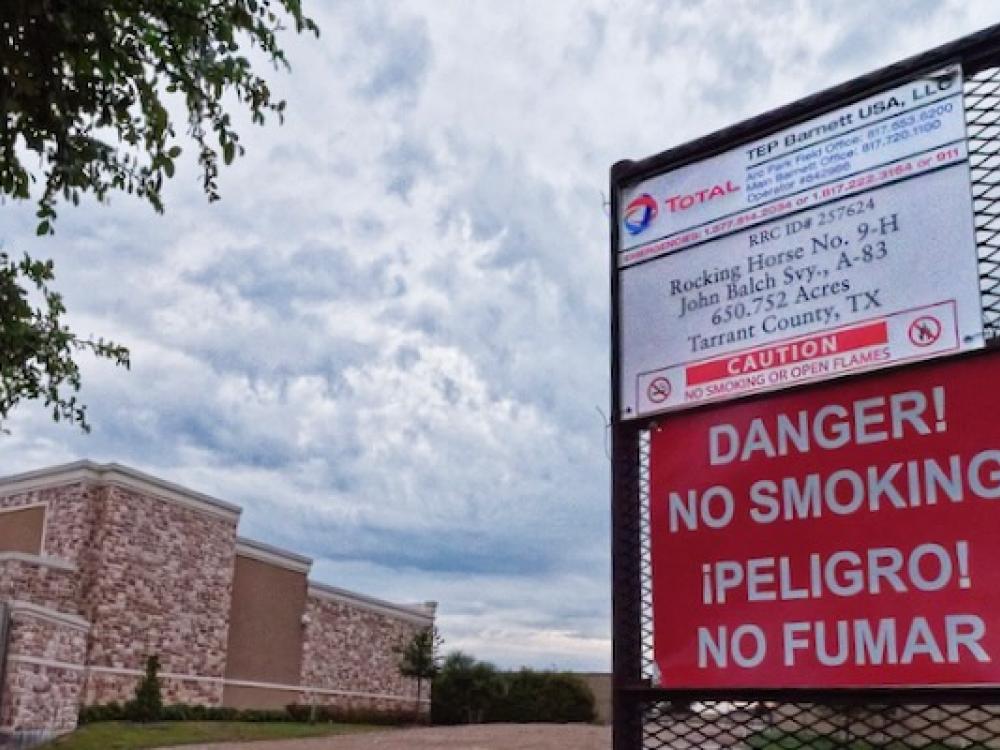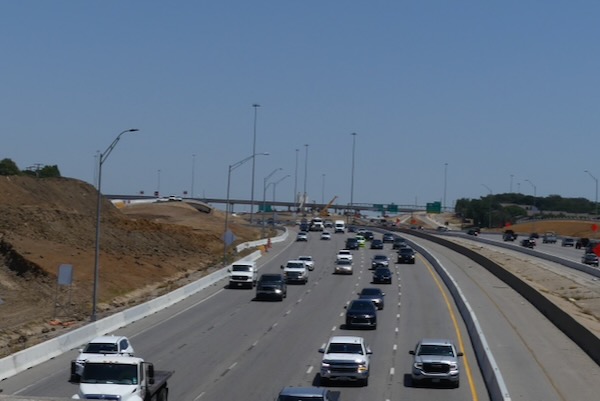
The Rocking Horse gas drilling site at 4945 South Collins Street in Arlington was named for a nearby preschool. Photo by J.G. Domke.
Jan. 12, 2024
Dallas-Fort Worth residents have a chance to express their views on the region’s climate action plan at public meetings hosted by the North Central Texas Council of Governments over the next few weeks and through an online survey.
NCTCOG is developing the Dallas-Fort Worth Air Quality Improvement Plan with funding from the Environmental Protection Agency to reduce greenhouse gas emissions and improve local air quality over the next five years.
Of the 16 counties served by NCTCOG, 10 counties — home to 96 percent of the region’s population — are out of compliance with federal air quality standards.
Public comment meetings regarding the air quality improvement plan will be held on Jan. 16 in Rockwall and Arlington (hybrid meeting with virtual option), Jan. 18 in Fort Worth, Jan. 29 in Cleburne and Feb. 15 in Arlington. A virtual session will be held on Jan. 24. Details here.
CREATING THE PLAN
NCTCOG received a $1 million planning grant during the first phase of the EPA’s Climate Pollution Reduction Grants Program to create a Priority Action Plan, outlining the region’s strategies for reducing greenhouse gas emissions. The plan is due to the EPA on March 1.
The council will then compete against other states, local governments, tribes and territories for $4.6 billion in implementation grants to fund the proposed solutions. North Texas would be eligible for up to $500 million to be awarded in fall 2024.
The timeline:
• Jan-Feb 2024: NCTCOG holds public comment meetings on DFW AQIP
• March 1, 2024: Priority Action Plan due to EPA
• April 1, 2024: Implementation grants application with quantified, specific measures due to EPA
• July 2024: EPA notifies implementation grant winners
• October 2024: Estimated start date for implantation grant awards
• July 3, 2025: Comprehensive Action Plan is due to EPA to address both near- and long-term solutions for reducing greenhouse gas emissions. The priority and comprehensive plans will together comprise the DFW AQIP
• July 31, 2027: Status report due to EPA
CALL FOR SOLUTIONS
 Transportation is the second leading cause of regional air pollution emissions at 43 percent. Photo by Michael Smith.
Transportation is the second leading cause of regional air pollution emissions at 43 percent. Photo by Michael Smith.
The EPA is seeking solutions that could be fully implemented within five years after funds are disbursed, said Savana Nance, senior air quality planner at NCTCOG.
NCTCOG created a list of potential strategies to improve air quality and reduce greenhouse gases.
“We will be narrowing down that list based on public feedback on what's important and then based on which measures fit the EPA's criteria,” Nance said. “The third thing that we're going to be looking at is which measures are actually able to be done at a local level.”
The finalized plan will focus on the energy and transportation sectors, which generate 53 percent and 43 percent of regional emissions respectively, according to a 2019 greenhouse gas inventory conducted by NCTCOG. Emissions from the energy sector refer to the total polluting energy used for residential, commercial and industrial use.
The finalized plan will focus on the energy and transportation sectors, which generate 53 percent and 43 percent of regional emissions respectively, according to a 2019 greenhouse gas inventory conducted by NCTCOG.
One potential project is weatherizing the energy sector in North Texas, which could include installing more battery storage, adding solar options and providing rebates on energy-efficient windows and appliances, said Nance.
“I think we all remember what happened with the winter storm, and there's lots of opportunities to improve the region's resiliency and also save people money,” Nance said.
Other regional measures that could be implemented within the timeline include adding and increasing the frequency of transit lines, replacing older diesel vehicles with cleaner models and using new technology that detects traffic flow at signal lights to reduce idling.
Local governments also provided NCTCOG with feedback on what projects they want to implement or expand within their jurisdictions.
“I live in the city of Denton, and they have an amazing home solar rebate that they always run out of money for,” said Nance. “There’s just too much demand for some of the things that local governments are doing.”
If awarded the implementation grant, NCTCOG would administer sub-awards to local governments that request the funds for emission-reducing projects. Some funds may be retained by the council for regional projects.
The Texas Commission on Environmental Quality will also submit an application for a statewide implementation grant. The NCTCOG and TCEQ teams must coordinate on planned measures because the EPA will not fund multiple grants with the same goals in the same area.
In addition to DFW, the Austin, El Paso, Houston, McAllen and San Antonio metro areas received planning grant awards and will file Priority Action Plans by March 1.
FAILING GRADE
The North Texas area is one of the worst nationally for air quality.
Last year, Dallas-Fort Worth was ranked the 18th most polluted city by the American Lung Association. Collin, Dallas, Denton and Tarrant counties received ‘F’s on the report and have exceeded federal ground-level ozone standards since at least 1992.
In 2022, the EPA moved North Texas from moderate to severe nonattainment with the 2008 air quality standard requiring 75 or fewer parts per billion of ozone. If the region does not reduce ozone levels by 2026, the area could be hit with millions in fines, according to the Fort Worth Report.
Ground-level ozone also poses risks to residents.
“We know there are health impacts, such as increased asthma [and] respiratory issues, that come with ground-level ozone being as high as it is in the region,” said Nance.
North Texas childhood asthma rates exceed both state and national standards.
Officials hope to reduce greenhouse gases and bring DFW into attainment with air quality standards by implementing the climate action plan.
Meanwhile, clean air activists say the plan is a long-awaited positive development, but needs to go further.
Ranjana Bhandari, founder and director of the grassroots environmental organization Liveable Arlington, urged NCTCOG to address methane emissions from fracking.
North Texas sits atop the Barnett Shale, one of the largest methane gas fields in the country. Methane, while short-lived, has roughly 80 times more global warming potential than carbon dioxide within the first 20 years after it is emitted and contributes to the formation of ground-level ozone.
This video was taken at the Dalworthington Gardens compressor station in Arlington, Texas on March 22, 2016, by an Infrared Training Center certified thermographer. The video was taken using a FLIR GF320 designed to scan large areas rapidly and pinpoint leaks in real time. Courtesy of Liveable Arlington.
“People focus on carbon emissions when they develop climate plans. We have to worry about methane as well,” said Bhandari.
North Texas sits atop the Barnett Shale, one of the largest methane gas fields in the country. Methane, while short-lived, has roughly 80 times more global warming potential than carbon dioxide within the first 20 years after it is emitted and contributes to the formation of ground-level ozone.
In the wake of new methane rules from the EPA, activists are asking for the state to rapidly adopt a new plan to identify and reduce leaks from oil and gas equipment, such as storage tanks and compressor stations.
“The state technically has 18 months to submit their methane plan, but we see no reason why they can't finish that plan and get that going as soon as possible,” said Rita Beving, the North Texas organizer for Public Citizen and a technical adviser on the City of Dallas Comprehensive Environmental and Climate Action Plan.
Bhandari requested NCTCOG for a moratorium on drilling in DFW until the plan is enacted.
“Let's monitor, measure, account for and plug methane emissions from fracking in the Barnett Shale counties, and eventually phase [natural gas] out as part of our transition to renewable energy,” said Bhandari.
Along with methane, fracking produces other pollutants that harm air quality and public health, including the carcinogen benzene, which causes leukemia. Studies also show that air pollution disproportionately affects vulnerable groups, including majority-minority and lower-income communities.
“If we act on plugging methane emissions, we're also removing a very major source of disease for children in the air,” said Bhandari.
Bhandari and Beving supported measures within the plan to reduce transportation emissions, develop community solar and create energy-efficient infrastructure, such as increased electric vehicle charging stations and updated building codes.
“There is so much to be done,” Bhandari said. “But [the DFW AQIP] can be truly transformational for the region.”
Beving encouraged community members to speak up on their priorities for the plan.
“This opportunity does not come up very often, where these kinds of grant funds are available, and I would urge the public to get involved,” she said.
HOW TO GET INVOLVED
Community members can attend public comment meetings to share concerns and priorities for the plan on Jan. 16 in Rockwall and Arlington (hybrid meeting with virtual option), Jan. 18 in Fort Worth and Jan. 29 in Cleburne and Feb. 15 in Arlington. Residents can also register for a virtual session on Jan. 24. The latest meeting information is posted here.
Public comment meetings regarding the DFW Air Quality Implementation Plan will be held on Jan. 16 in Rockwall and Arlington, Jan. 18 in Fort Worth and Feb. 15 in Arlington. A virtual session will be held on Jan. 24. Details here.
Residents unable to attend the meetings can complete an online survey to share their views on potential greenhouse gas reduction strategies. Corporations, local governments and other entities that could implement measures can complete a separate survey here.
NCTCOG will accept public feedback for the Priority Action Plan until the second week of February. Comments submitted later will be considered for the implementation grant application due in April.
To receive updates on the plan, sign up for emails on the NCTCOG DFW AQIP page.
RELATED ARTICLES
EPA officials visit the Barnett Shale — ground zero of the fracking boom
Portable air monitors are latest tool for North Texas activists
Arlington activists push back on new gas drilling
Dallas climate plan passes unanimously by virtual vote
Stay up to date on everything green in North Texas, including the latest news and events! Sign up for the weekly Green Source DFW Newsletter! Follow us on Facebook, X and Instagram. Also check out our new podcast The Texas Green Report, available on your favorite podcast app.









